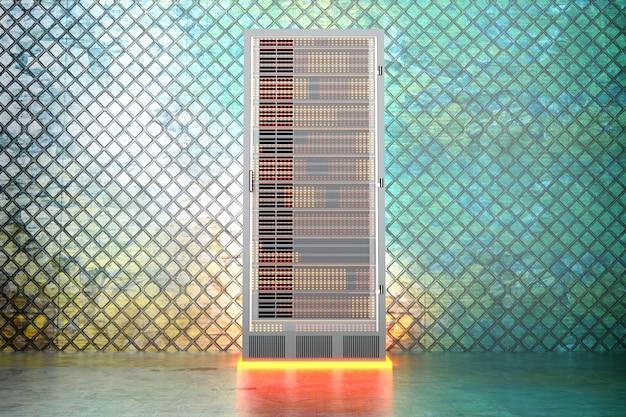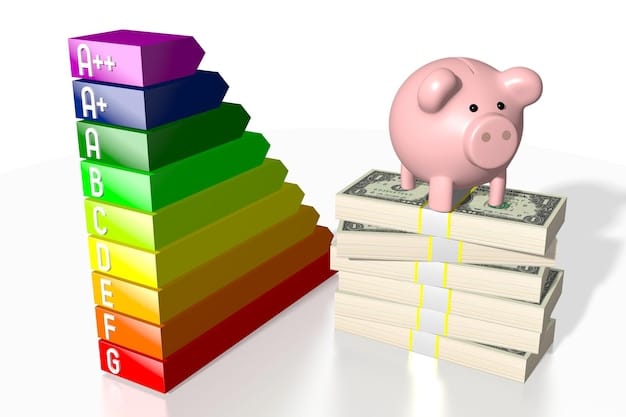Are New Appliance Efficiency Standards Costing You More?

Is the new federal appliance efficiency standard costing you more than it saves? It’s a question many consumers are asking as they face higher upfront costs for appliances designed to consume less energy, balancing initial expenses with potential long-term savings.
Are you wondering if the new federal appliance efficiency standards are really benefiting your wallet, or if you’re paying more upfront for limited long-term savings? The question, is the new federal appliance efficiency standard costing you more than it saves?, is a concern for many consumers.
Understanding the New Federal Appliance Efficiency Standards
Federal appliance efficiency standards aim to reduce energy consumption and lower utility bills, but they often come with a higher price tag. Let’s delve into what these standards entail and how they affect consumers.
The goal of these regulations is to encourage manufacturers to produce more energy-efficient appliances, thereby reducing the overall demand on the power grid and lessening environmental impact. However, the shift towards compliance isn’t always straightforward for either manufacturers or consumers.
What Do the Standards Entail?
The standards set minimum energy performance levels for various types of appliances. This can involve anything from refrigerators and washing machines to air conditioners and water heaters.
How Are They Enforced?
The Department of Energy (DOE) is primarily responsible for setting and enforcing these standards, employing rigorous testing and compliance procedures to ensure that manufacturers meet the required benchmarks.
- Stringent testing protocols ensure appliances meet efficiency requirements.
- Manufacturers face penalties for non-compliance, driving adherence.
- Standards are periodically updated to reflect technological advancements.
The impact of these standards varies depending on the appliance and individual usage. While some households may see substantial savings, others might find the higher upfront costs outweigh the long-term benefits, sparking the question of, is the new federal appliance efficiency standard costing you more than it saves?.

The Initial Cost Factor of Energy-Efficient Appliances
One of the most immediate concerns for consumers is the higher price of energy-efficient appliances. While they promise long-term savings, the initial investment can deter many buyers. Let’s explore the factors driving up these costs.
Manufacturers often incorporate advanced technologies and materials to meet stringent efficiency standards. These innovations increase production costs, which are then passed on to consumers. Consequently, it’s essential to understand the lifecycle cost rather than just the purchase price.
Technology and Materials
Energy-efficient appliances often include features like advanced insulation, variable-speed compressors, and smart sensors, which require significant R&D investment.
Manufacturing Processes
The precision manufacturing needed to comply with efficiency standards also adds to the overall cost of production, as companies must invest in specialized equipment and training.
- Advanced components increase production expenses.
- Specialized manufacturing processes add to the cost.
- R&D investments in energy-saving technologies contribute.
The challenge lies in balancing the upfront costs with the potential long-term savings. While some consumers may be able to afford the initial investment, others may find it prohibitive, especially those on a tight budget, making them question, is the new federal appliance efficiency standard costing you more than it saves?.
Long-Term Savings: Do They Outweigh the Costs?
The primary justification for higher upfront costs is the promise of long-term savings through reduced energy consumption. But do these savings really outweigh the initial investment? Let’s examine the factors affecting actual long-term savings.
Energy-efficient appliances are designed to consume less energy over their lifespan, resulting in lower utility bills. However, the actual savings depend on various factors, including energy prices, usage patterns, and the appliance’s durability. Therefore, a comprehensive analysis is necessary to determine if the financial trade-off is worthwhile.

Factors Affecting Savings
Several variables can influence the actual savings achieved. These include energy prices, usage habits, and the appliance’s lifespan.
Real-World Examples
To illustrate, consider a household that replaces an old refrigerator with a new energy-efficient model. The savings on electricity bills could be significant over several years, potentially offsetting the higher purchase price.
- Energy prices fluctuate, affecting potential savings.
- Household usage patterns impact energy consumption.
- Appliance lifespan determines long-term cost-effectiveness.
The equation of, is the new federal appliance efficiency standard costing you more than it saves? hinges greatly on individual circumstances. A household with high energy consumption and stable income may benefit substantially, while another with lower consumption and limited financial resources might not see equivalent advantages.
The Impact on Different Household Types
The financial impact of new appliance efficiency standards can vary significantly across different household types. Factors such as income level, energy consumption habits, and geographic location play a crucial role. Let’s consider some scenarios.
Lower-income households may struggle with the upfront cost of energy-efficient appliances, even if they would benefit from long-term savings. Conversely, higher-income households might find the initial investment less of a burden and can readily enjoy the reduced energy bills. Understanding these disparities is vital for equitable policy implementation.
Lower-Income Households
For families with limited financial resources, the upfront cost can be a significant hurdle. Government subsidies and rebates can help bridge this gap.
Higher-Income Households
Affluent households can more easily afford energy-efficient appliances, accelerating their adoption and maximizing savings over time.
- Lower-income households need financial assistance to adopt new standards.
- Higher-income households can more easily invest in energy efficiency.
- Renters often lack control over appliance choices, limiting savings.
Addressing the question, is the new federal appliance efficiency standard costing you more than it saves? requires tailored solutions. Financial incentives, educational programs, and flexible financing options can ensure that all households, regardless of their economic status, can benefit from energy-efficient appliances.
Government Incentives and Rebates
To encourage the adoption of energy-efficient appliances, many governments offer incentives and rebates. These programs aim to offset the higher upfront costs and make energy-efficient options more accessible to a broader range of consumers. Let’s examine some common types of incentives.
Rebates are often provided at the point of sale or through mail-in applications, reducing the effective purchase price. Tax credits can be claimed when filing annual taxes, offering a longer-term financial benefit. Both mechanisms play a crucial role in promoting energy conservation and reducing the burden on consumers.
Types of Incentives
Various incentives exist to support the adoption of energy-efficient appliances. These include rebates, tax credits, and financing programs.
How to Access Incentives
Consumers can research available incentives through government websites, utility companies, and appliance retailers. Application processes vary, so it’s essential to understand the requirements and deadlines.
- Rebates reduce upfront costs at the point of purchase.
- Tax credits provide longer-term financial benefits.
- Financing programs offer low-interest loans for energy-efficient upgrades.
Effectively leveraging these incentives can significantly alter the answer to, is the new federal appliance efficiency standard costing you more than it saves?. By reducing the initial financial burden, such programs make energy-efficient options more attainable and economically attractive for a wider range of households.
Making Informed Decisions: A Consumer Guide
Ultimately, deciding whether to invest in new energy-efficient appliances requires careful consideration. Consumers should weigh the upfront costs against the potential long-term savings and consider their individual circumstances. Let’s outline some key steps for making informed decisions.
Start by assessing your energy consumption patterns and identifying appliances that consume the most energy. Research available incentives and rebates to reduce the initial cost. Finally, compare different models and brands to find the best balance of efficiency, features, and price. Informed choices lead to better financial outcomes.
Assess Energy Consumption
Identify the appliances that consume the most energy in your home. This will help prioritize upgrades and focus on the most impactful changes.
Research Incentives
Explore available rebates and tax credits to reduce the upfront cost of energy-efficient appliances. Take advantage of government and utility programs.
- Evaluate your energy consumption patterns to identify key areas for improvement.
- Research available incentives and rebates to minimize upfront costs.
- Compare different models and brands to find the best value.
The answer to, is the new federal appliance efficiency standard costing you more than it saves? is highly personal. However, by taking a proactive and informed approach, consumers can make choices that align with their financial goals and environmental values, ensuring a win-win outcome.
| Key Aspect | Brief Description |
|---|---|
| 💰 Upfront Costs | Energy-efficient appliances often have higher initial prices due to advanced technology. |
| 💡 Long-Term Savings | Reduced energy consumption can lead to significant savings on utility bills over time. |
| 💸 Government Incentives | Rebates and tax credits can help offset the initial costs, making energy-efficient options more affordable. |
| 🏡 Household Impact | The financial impact varies depending on income, energy consumption, and geographic location. |
Frequently Asked Questions
▼
Energy-efficient appliances can be worth it in the long run, as they reduce energy consumption and lower utility bills. The key is to assess your usage and compare lifecycle costs.
▼
Check government websites, utility companies, and appliance retailers for information on rebates and incentives. Each program has its own application process and eligibility criteria.
▼
Energy prices, household usage patterns, and the appliance’s lifespan all affect long-term savings. High energy prices and consistent usage maximize savings.
▼
Yes, energy-efficient appliances reduce overall energy consumption, leading to lower carbon emissions and a smaller environmental footprint, contributing to sustainability efforts.
▼
Assess your energy needs, research available incentives, and compare different appliance models. Consider both upfront costs and potential long-term savings for the best value.
Conclusion
In conclusion, determining whether new federal appliance efficiency standards save you money requires a balanced evaluation. While higher upfront costs can be a barrier, the promise of long-term savings, combined with available incentives, can make energy-efficient appliances a worthwhile investment for many households, aligning financial benefits with environmental responsibility.




